With so much going on this weekend, somehow I still managed to sneak out with my son to enjoy a lecture by notable botanist Bill Carr. He was speaking about rare native plants of Travis County, and I’m happy to report that even my son took notes, a rare occurrence of its own (his middle-school teachers would be proud).
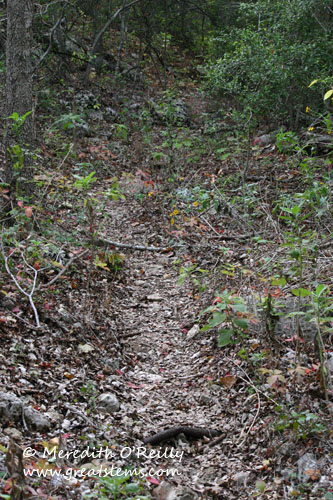 Afterwards, we took a short hike through part of the Balcones Canyonlands Preserve. This small portion of the preserve happened to be owned and managed by Concordia University under the guidance of Travis County Parks and Wildlife. We didn’t find any of the rare plants Bill mentioned during his lecture (it’s okay, because we weren’t expecting to). But we did see some other plants special for reasons all their own.
Afterwards, we took a short hike through part of the Balcones Canyonlands Preserve. This small portion of the preserve happened to be owned and managed by Concordia University under the guidance of Travis County Parks and Wildlife. We didn’t find any of the rare plants Bill mentioned during his lecture (it’s okay, because we weren’t expecting to). But we did see some other plants special for reasons all their own.
It being fall, and fall after a drought at that, many plants were in various stages of winter prep. As such, when we happened upon a beautiful bloom, it stood out all the more. Here’s the lovely Plateau Goldeneye (Viguiera dentata), a member of the Aster family. That means it’s related to sunflowers, artichokes, and lettuce, of all things. I just love taxonomy.
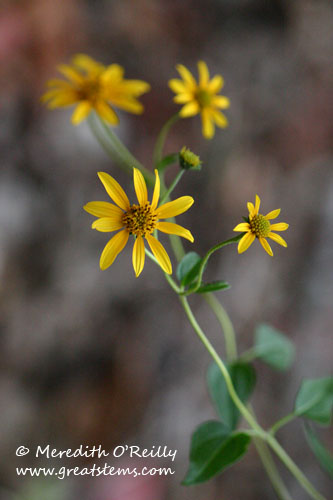
In several areas along the modest trail, the five-leaved vine Virginia Creeper (Parthenocissus quinquefolia) was showing off its red fall colors.
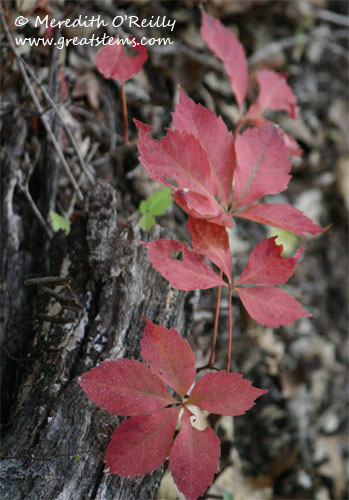
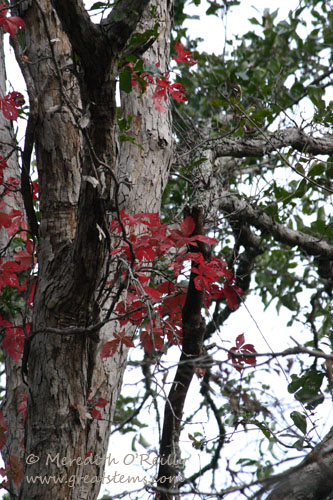 It can grow remarkably high in a tree. Berries of this plant are an important winter food source for birds.
It can grow remarkably high in a tree. Berries of this plant are an important winter food source for birds.
Another vine abundant at the preserve was Alabama Supple-jack (Berchemia scandens). Commonly known as Rattan Vine for its wicker-like properties, Supple-jack was easily located thanks to its remarkably thick, twisting vines.
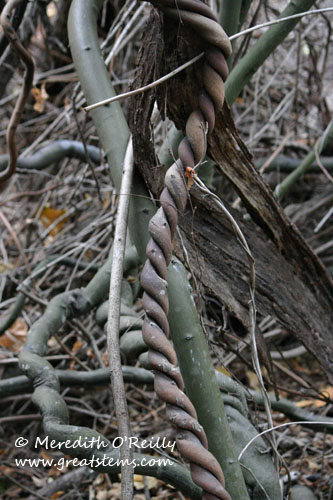
If it looks wickedly strong, that’s because it is.
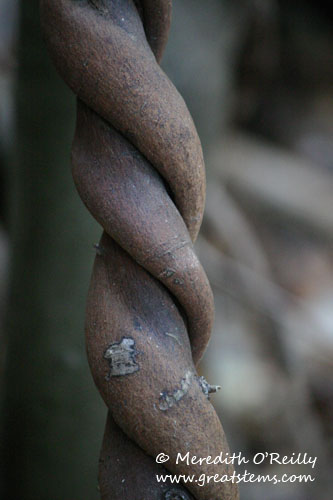
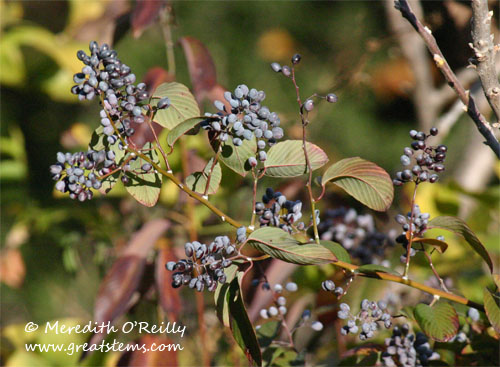 The bluish fruits are popular with birds and small mammals, and as you can tell from the numerous berries in the image above, it’s got a pretty good chance for making more little Supple-jack babies. That’s a pretty good thing if you are a bird or a small mammal — not such a good thing if you are a tree that has to support one or more of the vines.
The bluish fruits are popular with birds and small mammals, and as you can tell from the numerous berries in the image above, it’s got a pretty good chance for making more little Supple-jack babies. That’s a pretty good thing if you are a bird or a small mammal — not such a good thing if you are a tree that has to support one or more of the vines.
Below, Late Boneset (Eupatorium serotinum) is showing off its striking profile.
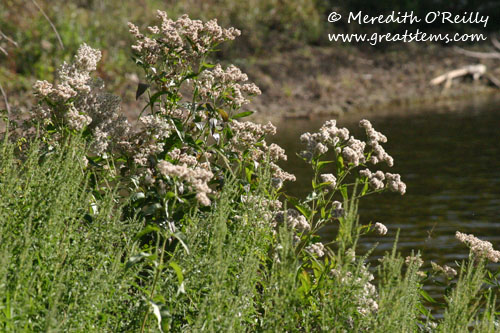
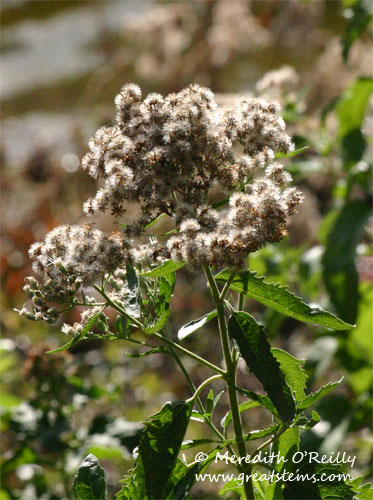 It likes more moisture than its cousin Shrubby Boneset (Ageratina havanensis) requires, but it’s just as great a nectar source. Guess what? Like Plateau Goldeneye, it’s in the Aster family.
It likes more moisture than its cousin Shrubby Boneset (Ageratina havanensis) requires, but it’s just as great a nectar source. Guess what? Like Plateau Goldeneye, it’s in the Aster family.
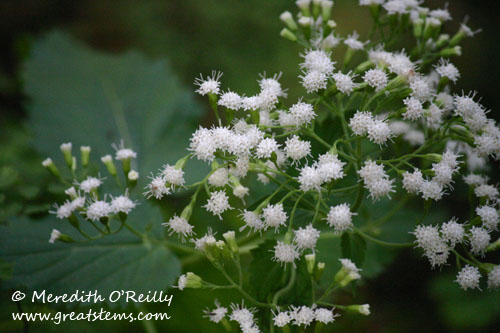 Shrubby Boneset was also at the preserve, growing farther back in the woodlands. A distinguishing characteristic is that its floral disks are less clumped than those of the Late Boneset.
Shrubby Boneset was also at the preserve, growing farther back in the woodlands. A distinguishing characteristic is that its floral disks are less clumped than those of the Late Boneset.
How about a plant that actually has “aster” in the name? Here’s Texas Aster (Symphyotrichum drummondii var. texanum).
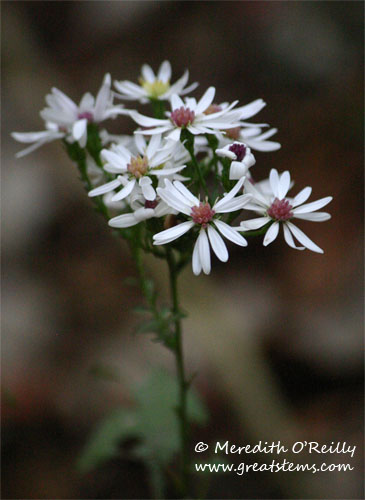
It’s always such a pretty sight when walking in woods of the Edwards Plateau.
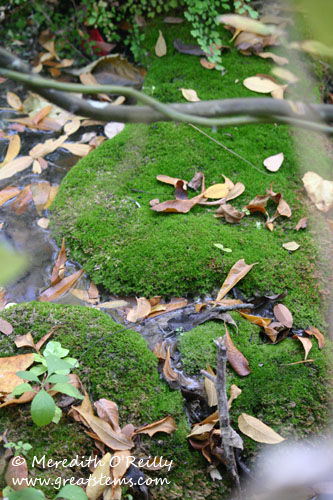 Every once in a while, if you are really, really, lucky — or at least somewhere that happens to have water — you get to see moss in Texas. We need more water here so that we can have more moss. I declare it.
Every once in a while, if you are really, really, lucky — or at least somewhere that happens to have water — you get to see moss in Texas. We need more water here so that we can have more moss. I declare it.
American Sycamore (Platanus occidentalis), as seen below, is such a pretty tree. The fruits are the oddest little round balls.
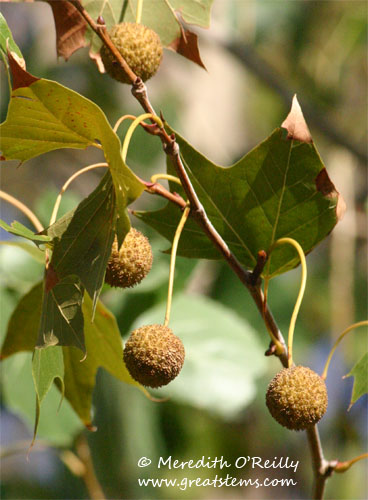
In the spring when these balls first form, they are covered with little individual flowers, each of which eventually forms an individual seed. So a seed ball is made of many seeds, not just one big one that can whack you on the head when it falls after winter passes.
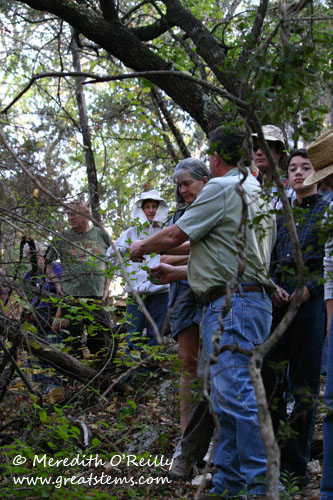 Here’s our guide, botanist and author Bill Carr. As we were walking along, he’d suddenly stop to show us an obscure little plant and tell us many wonderful things about it. Needless to say, those of us who walked with him didn’t manage to walk as far as the other group — there were too many plants to stop and admire! But oh did we learn a lot. If you have a chance to take a hike with a botanist, especially one as knowledgeable as Bill Carr, I highly recommend it.
Here’s our guide, botanist and author Bill Carr. As we were walking along, he’d suddenly stop to show us an obscure little plant and tell us many wonderful things about it. Needless to say, those of us who walked with him didn’t manage to walk as far as the other group — there were too many plants to stop and admire! But oh did we learn a lot. If you have a chance to take a hike with a botanist, especially one as knowledgeable as Bill Carr, I highly recommend it.
Stunning pictures and great information. Thanks for the post.
Great photographs. I especially like the one with the Virginia Creeper up the tree and also the one with moss. We are rather short of moss this year…
BCP is a gem. Thanks for profiling this lovely place.
Thanks, Marilyn — I love showing off some of Texas’ wonderful plant beauties.
I love moss the way I love thorny plants, although today my son fell into my newest thorny shrub and got a few scratches. Alas. With moss, I think it might be the color of the green that appeals most to me.
Wonderful blog, good job
Un Saludo
Interesting about the two Eupatorium. I may have seen the late one and never recognized it. Also the sycamore- I found a leaf in our garden the other day. It must have blown quite a distance as we have none in the immediate vicinity. Thanks for an insight into plants I might have missed when walking the trails.
Thanks for the virtual tour Meredith – a guided tour with a knowledgeable naturalist is SO worth taking some time out of life for! The Supple-jack vine is astounding – never even heard of it. The twining stems look like rope – are those living stems?
I’ve not ever seen the rattan vine – I’ll be on the lookout for it now. What a great hike you had!
Looks like a great field trip! As usual, beautiful photography! Hey, I’m curious…I’m in search for a new camera and wondered if you could email me and let me know what you use, if you’re happy with it, and any pros and cons. I’d love it! Thanks again. I can be reached at jen@gardenstems.com. Have an awesome day.
They are, Ellen. Aren’t they amazing?
Jordi, thanks!
I was very glad to learn about Late Boneset, too — it makes me wonder whether I’ve confused it with Shrubby in the past. I don’t think so, but you never know.
Cynthia, I’ve seen it in other woodlands, but I never really knew what vine I was looking at. Now I’ll look for it with more intrigue, that’s for sure.
Doing it now, Jeni!